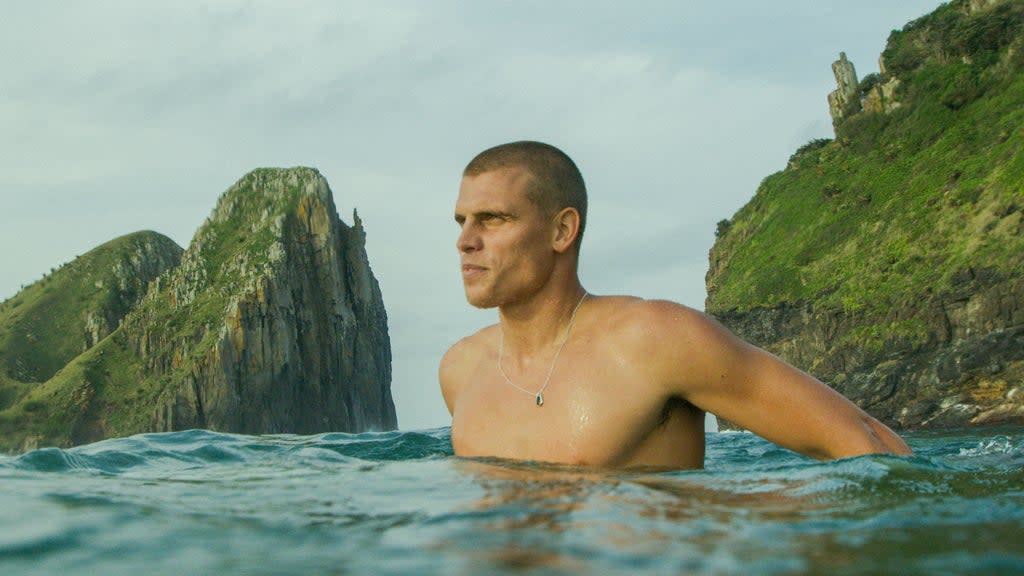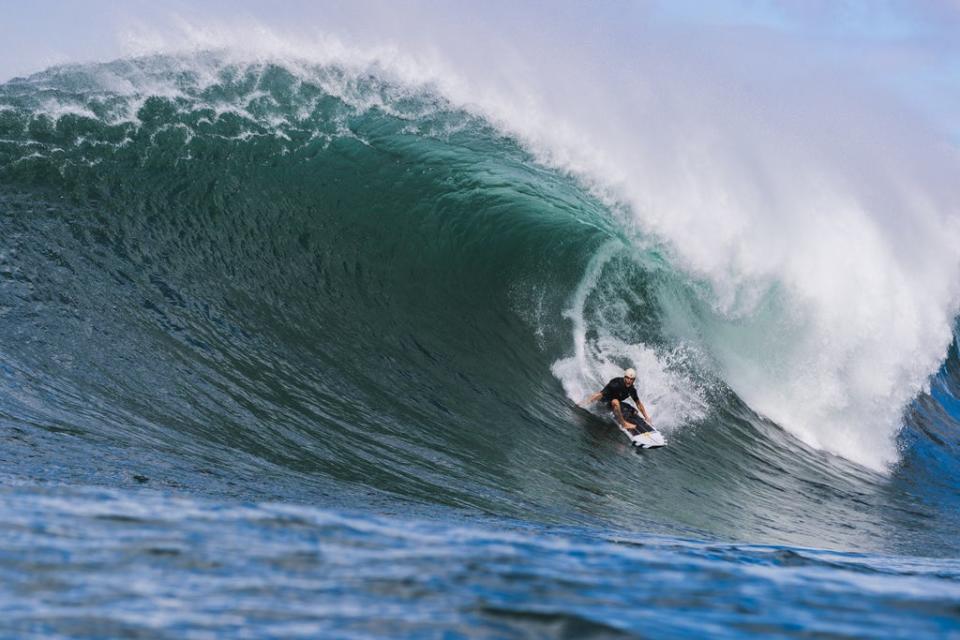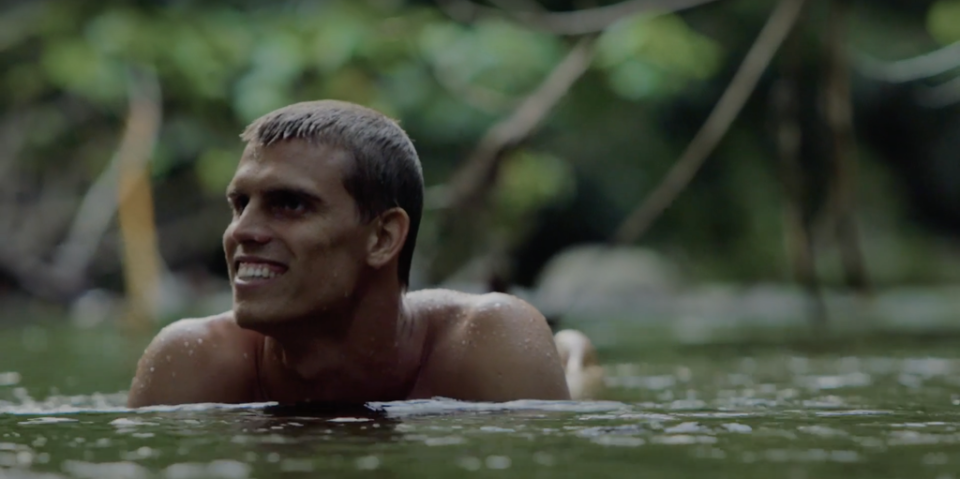How psychedelic mushrooms helped pro surfer Koa Smith overcome depression and trauma: ‘I never slipped back’

Surfing is a sport of frontiers. You enter a wave the exact moment it begins to shift, when it has reached its peak power, just before that energy causes it to fold over itself and collapse. You seek out points on the map where storms thousands of miles away, rolling across the ocean-floor geography, have channeled swells towards land. You experience a departure from the body itself, a feeling of perfect, ego-dissolving synchronization with the rhythms of the ocean—or the three-dimensional chaos of being flipped off a moving tunnel of water and careening in the undersea dark.
These are frontiers that pro surfer Koa Smith knows better than almost anybody.
The Kaui-born surfer has ridden some of the most spectacular waves on Earth, from the North Shore of Oahu to Namibia and back.
After a shock injury on a reef in Indonesia in 2018, he pushed into frontiers that athletes, let alone modern science, are only just beginning to explore.
To heal from a catastrophic head wound, and the depression and trauma he experienced as a result, he began a journey with psychedelic psilocybin mushrooms.

The experience, chronicled in the new film Resurfacing, changed his life. According to medical experts on the cutting edge of psychedelic research, it could soon change many more.
‘Maybe I was leaving my body’
In 2018, Koa came to the Indonesian island of Nias on a high. He was well on his way to the kind of surfing life he dreamed about as a kid growing up and surfing each day in Kauai: traveling the world, competing in contests, modeling in magazines.
He’d just completed his third trip to Namibia’s Skeleton Bay, where a video went viral of him riding for minutes on a wave with eight separate “barrels,” sections where the surfer is riding inside the open tube of a crashing wave. In a sport where ever the best surfers ride waves that last just seconds, the clip, filmed in the waters off the ochre Namibian desert, is a surfer’s fantasy made real.
Smith — who often woke up before dawn, surfed all day, then partied all night — wanted to keep pushing like he always did, so he hopped on a plane from Hawai’i back across the world a few days later when he saw a big swell was heading towards Indonesia. After driving for hours through the jungle, he reached Nias, a remote village with a beautiful wave like one he grew up surfing.
A few tries into his first session, a rogue set of waves far more powerful that the rest came thundering towards the beach. He decided to go for it anyway.
He lost control — jumped off his board — flipped through the air. His head hit something. Hard. Lights out.
“I heard this crazy, super peaceful violin,” Mr Smith told The Independent in March, sitting on a sun-dappled patio in Los Angeles. “I had one of those moments where I was above the whole bay looking down. I could see my friends in the lineup. I could see the boats in the bay. I could see the mountains. Then all of a sudden I realized that I was actually underwater.”
But he wasn’t afraid.
“I felt maybe I was leaving my body,” he continued. “The weird thing was it was a very comfortable, very loving, euphoric state. There was no fear. It was just like being home.”
That high wouldn’t last. When he came to, there were bloody coral scrapes across his arms and head. He couldn’t remember his own name, where he was staying, or in which direction lay the shore.
Somehow, he made it back to land. A local man who recognised him gave him a ride on a moped back to where the surfer was staying. He was home free, but he wasn’t out of troubled waters yet. He had a severe concussion, which would test him in ways he never expected.
‘Something just broke in me’
After recuperating in Bali for two weeks, he flew to California for the 2018 US Open of Surfing contest. He immediately knew something was off. The whole event was overstimulating: crowds of fans across Huntington Beach. Questions from reporters and sponsors about his injury. Flashbulbs and the pound of the waves.
“Something just broke in me,” he said. “I couldn’t even function anymore. I ended up losing luckily in the contest. From there I had to spend ten hours a day in my bed in the dark and just kind of figure out what I wanted to do from there.”
Five months, six months, seven months went by and he still couldn’t get in the water. He began wondering if he would ever surf again. A “deep, numbing” feeling came over him.

“My life is good. I had a beautiful girl friend, very loving. I had my family, who was there to support me, very close to me. A beautiful house on the beach. I live in Hawai’i. My life should be amazing,” he said. “But I had this crazy numbness over me, where I couldn’t feel happiness, I couldn’t feel excitement. I was just f***ing down, numb, and dead feeling.”
In that depression, he began having scary, recurring thoughts.
“Part of the concussion was I had these repetitive thought processes that I couldn’t control,” he said. “Like a wheel is turning, committing suicide, that just keeps replaying and faster and faster until your brain starts getting getting super hot and melting almost, and I would have to call someone and have conversations with them or go jump in the ice bath or go on a forest walk just to slow that wheel down. It would get so painful and so crazy.”
He tried seeing doctors, but their answers weren’t satisfactory. At the hospital, one condescending specialist said they didn’t want to scan Smith’s brain because if it looked good, the hard-charging surfer would just get back in the water again. A therapist recommended antidepressants, but Smith felt the answers to healing were already inside of him somewhere.

“Growing up so close to nature, in the forest, in the ocean, eating just organic, farm food, I knew what was healing. I knew that my body had the answers unless of course there’s something extreme,” he said. “I knew that it was time to figure something out.”
That’s when he decided to try incorporating psilocybin mushrooms into his healing process.
‘I never slipped back into that numbness’
In search of a peaceful and nourishing setting for their journey, Koa and his brothers headed into the jungle on Kauai, until they reached a freshwater pond fed by a very cold stream. They sat in the sun, naked, practising breathing techniques from Wim Hof, a Dutch extreme athlete whose breath work techniques have helped him perform astounding feats like climbing snowy Mount Kilimanjaro in just shorts.
Koa was again outside of himself. This time, instead of violins, he heard a voice, first speaking, then screaming at him until he got the message.
“This voice came to me and reminded me of who I was,” he said. “It took me back to my childhood, that fire inside me as a child. It reminded me that I was a good person and that I was here to do good in this world. It reminded me that I should use my head injury as a guide to healing.”

For the first time in a long time, he felt connected to himself and his body again. For the first time in a long time, he loved that person he was connecting to.
“That was the moment that brought me back from depression,” he said. “I never slipped back into that numbness again.”
Two weeks later, he started surfing again, and he hasn’t stopped since.
These moments of radical shifts in perspective hold immense promise for the treatment of mental health issues, PTSD, substance abuse disorders, and other ailments, according to scientists. Thanks to recent changes in research policy, we are now in the midst of a “psychedelic renaissance,” where experts are trying to unpack just what makes people like Koa have such profound experiences of healing on psychedelics — and how to bring it to the masses safely and without fear of prosecution from the government.
A reset of the brain’s historical patterns
Indigenous peoples the world over have been using psychoactive plants for millennia for healing and ceremonies, but scientific research on these medicines has been stonewalled for decades in the US.
Amid a rising backlash to the counterculture, mushrooms and other compounds were moved into Schedule I by the Food and Drug Administration, meaning the government considered them to have no accepted medical use and high potential for abuse. Only recently have authorities begun considering rescheduling psychedelics.
In the mid-2000s, a pioneering group of researchers including those from Johns Hopkins University began to change things, rigorously studying the use of mushrooms and its potential applications.

Two decades later, we’re in the midst of a new flourishing, with places like Oregon and Oakland, California, decriminalising psychedelics, and researchers examining the potential to use such compounds for medical ailments ranging from depression to alcoholism. It’s a developing field, and experts caution people not to treat these drugs as proven cure-alls, or something to be explored without in-depth medical and spiritual guidance. Still, many are hoping that thousands of people might have a similar experience to the one Koa had.
Studies suggest mushrooms can reduce the activity of the default mode network, a part of the brain involved in identity formation and self-perception, according to Dorna Pourang, a drug development researcher who has helped lead psychedelic trials for the Multidisciplinary Association for Psychedelic Studies, and an adviser to MUD\WTR, the supplement and health food company which produced Resurfacing.
“When that activity is dampened, we’re not so tied to these things that create our identity and who we are,” she said. Instead, she continued, we “shift into interconnectedness."
Researchers often liken the impact of psilocybin to a fresh coat of snow on a sledding hill: it fills in the rutted mental pathways that guide one’s normal thought process, and people are free to chart new courses through the fresh powder of their mind.
This new openness and perspective can be a powerful complement to traditional therapy, according to Karina Sergi, a licensed psychotherapist at the Pacific Neuroscience Institute, who has worked on using ketamine for treatment-resistant mental health conditions and psilocybin in clinical trials.

“It can lead to a kind of recalibration or a reset of the brain’s historical patterns,” she said. “This kind of primes a person to benefit from the psychotherapeutic process.”
Psilocybin can also illicit a deep reconnection with the body, adds Alex Cardenas, a California-based community psychiatrist and co-executive director of the American Psychedelic Practitioners Assocation (APPA), an organisation working to create standards of care, public education, and greater acceptance within the healthcare system surrounding psychedelic medicine.
That reconnection with the physical could be especially vital for people like athletes, he says, for whom a close relationship with the body is at the core of what they do.
“Helping people recover from trauma, part and parcel of that is helping them connect to their body,” Mr Cardenas said, noting his opinions are personal and don’t necessarily reflect those of the APPA. “I do think these medicines can help people connect to their bodies. For people who live in their body, helping them be more aware of their relationship with their body could have all sorts of effects beyond helping with trauma.”
More than just these effects, many who use psychedelics report experiences similar to Koa’s, where they feel they’ve received a great piece of wisdom about themselves, or their place in the larger scheme of the world.
According to Ms Sergi, this mystical experience sometimes allows people to hold “conflicting truths” at the same time that help in their healing.
“A person might say something like, I’ve died several times but I’ve never felt so alive and ready to live my life,” she said. “I am simultaneously a speck in the universe but so powerful as to be able to create change in my world…The idea that they can be depressed but powerful. We can start to use that in the therapeutic process.”
‘There’s a lot of stigma that has to be overturned’
Still, despite these findings, and ongoing, scientifically sound research at prestigious institutions like Johns Hopkins, New York University, and University of California Berkeley, there’s still loads of stigma against psychedelics, left over from the War on Drugs and even earlier prejudices about medicines and rituals outside of the Western canon.
“There’s a lot of stigma that has to be overturned within the medical community,” according to Ms Pourang, the researcher. “If you’re working within the psychedelic community, everybody is really excited about it, but when you’re trying to bridge into the modern medical system, you’re going to come up against people whose doubts and reservations from the propaganda of the drug war that substances are not safe and have a lot more risk than the scientific data says they actually do.”
Both researchers and Koa himself warn to treat psychedelics lightly.
They’ve only been under serious study for a few decades, and scientists are still working out which conditions they might be most useful for, what sorts of supports and therapies are necessary for a safe and positive experience. They’re also trying to tackle some of the deeper physiological and philosophical questions surrounding psychedelics.
“From a research perspective, the questions are things like, for whom and for what disorders can these treatments be helpful? Questions like, is this purely a chemical reaction? Is this more of a psychological or spiritual experience? For whom and at what level is concurrent therapy necessary?” adds Mr Cardenas, the APPA psychiatrist.
It’s not all pretty visuals or mystical experiences, either. The mental unboundedness of a mushroom experience can be intense or traumatic in its own right, as people face parts of their mind or memories they’re unprepared to.
There’s no such thing as perfect medicine. It’s all in how they’re used.
“Psychedelics need to be respected. I don’t want to just encourage kids to go eat a handful of mushrooms. I feel like psychedelics are so wise and need to be treated with respect. You need to be ready. You need to have a guide so that you’re comfortable, so that you can let the layers go,” adds Koa Smith. “They need to be used for healing.”
The surfer hasn’t stopped chasing the best waves in the world, but his psychedelic journey inspired him to slow down, focus on holistic wellness, and share his story with others. In the adrenaline-fueled world of pro surfing, these themes are not always top of mind.
“I’ve already had so many people reach out to me with similar stories and just being very excited that I told this story,” he said. “This is going to be a big moment for me to help people. Just me being vulnerable and telling my story. I’m excited to see where I go next. I’m excited to keep my story out there.”
Four years on, he still feels like he’s healing from his crash in Nias, but with a new perspective.

“I’m stoked to just continue the healing process,” he said.
For people like Koa, who push the physical limits of what is possible every day, some of the toughest and most satisfying journeys are the ones that occur within.

